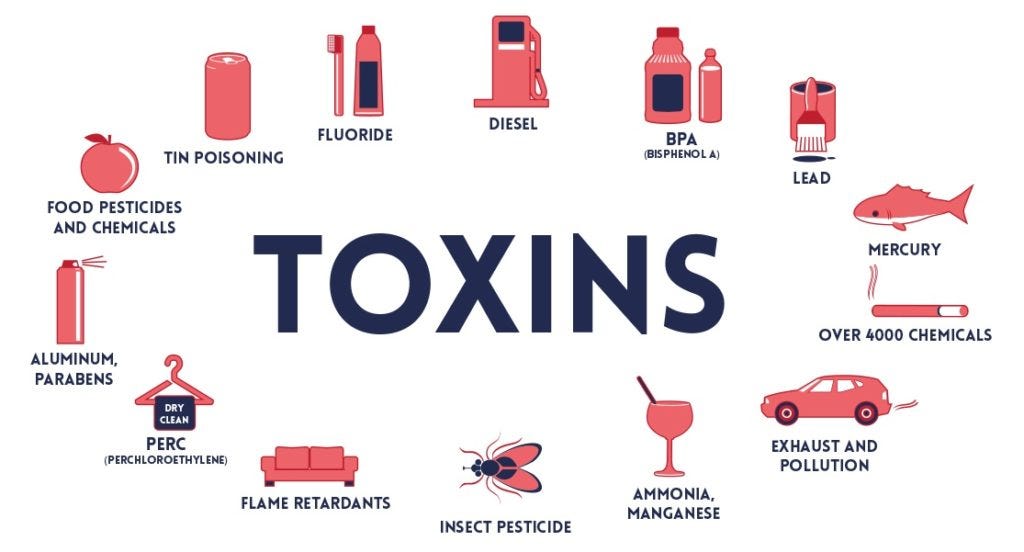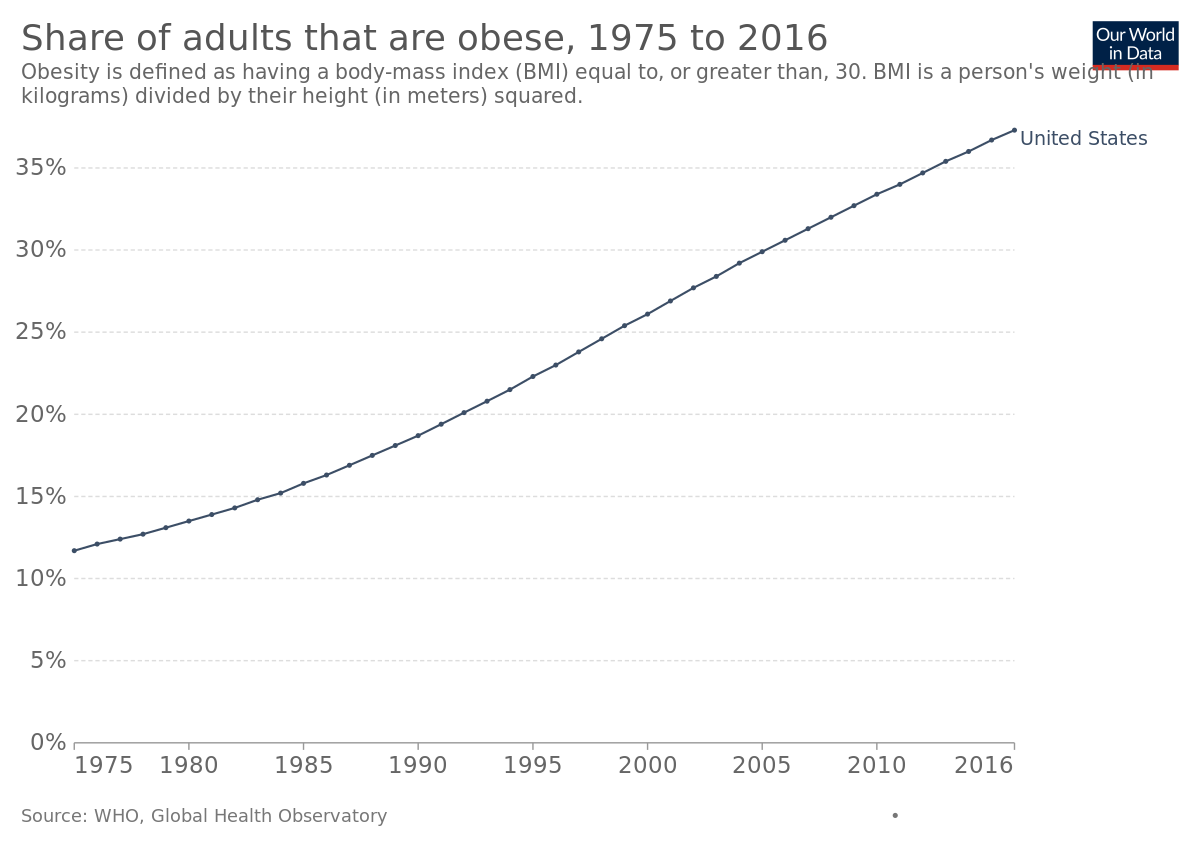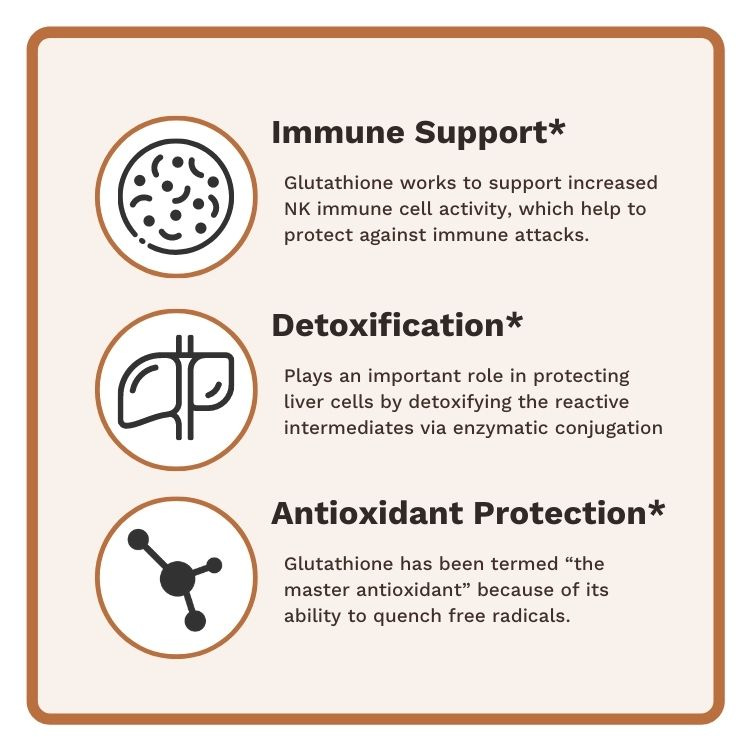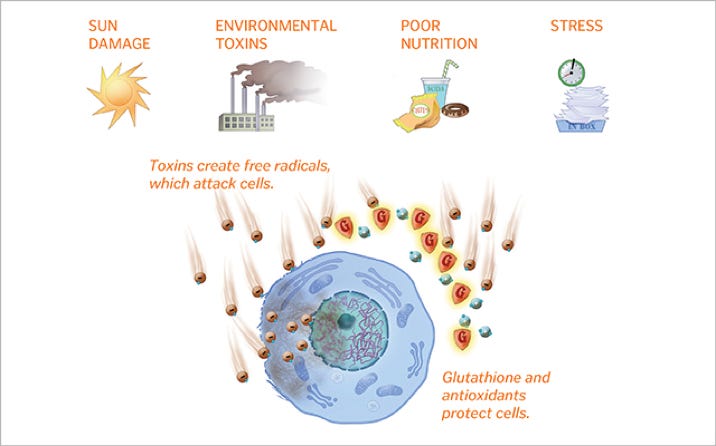Having Trouble Losing Weight? Toxins May Be Your Problem. Here's My Detox Protocol
Here are strategies to lower your toxic load so that you can easily drop excess body fat. The modern toxic bombardment signals the body to gain fat as a place to tuck away harmful substances.
In today’s post:
Many researchers believe that increasing environmental toxins are fueling the obesity crisis
The body uses fat to lock away toxins
A high toxic load may make losing weight difficult and gaining inevitable
Learning how to reduce exposure and neutralize toxins may be key to overcoming weight loss resistance
Boosting glutathione is a key strategy for detoxifying
A few other strategies to reduce toxins are explored
I love puzzles and problem-solving especially when it involves the intricacy of our amazing human body. I love the human body because the way it works reminds me of our extremely good natured Nova Scotia Retriever—his bent is to protect us and do the right thing.
This is how your body was made. When something is malfunctioning, there’s a protective reason why. This is where the problem-solving comes in. Trying to manipulate your body with drugs rarely works in the long term when it comes to chronic problems since drugs don’t tackle the root cause. But finding the root cause of a problem can change everything.
Based on everything I’ve learned, it seems likely that toxins are the main cause of weight gain and a major cause of weight loss resistance.
One of the primary reasons the body makes fat is that each fat cell is safe jail cell in which to lock away harmful toxins. Since your body prioritizes short term bodily safety over long term negative setbacks, it will create excess fat even though too much body fat has negative long term effects. This way, at least the body is safe from dangerous toxins in the meantime. The innate intelligence of the body hopes that in the future there will be fewer toxins, and it will happily eliminate the excess weight then. Here’s to hoping.
A number of researchers agree with me that toxins may be a key reason why the obesity rates continue to climb year over year.
For example, Dr. Mark Hyman published a paper titled Systems Biology, Toxins, Obesity, and Functional Medicine in which he says:
Environmental toxins interfere with metabolism, overload hepatic detoxification systems, disrupt central weight-control systems, promote insulin resistance, alter circadian rhythms, activate the stress response, interfere with thyroid function, increase inflammation, damage mitochondria, and lead to obesity. Most researchers have largely ignored the effects of environmental chemicals on metabolism. Still, a few researchers have started connecting the dots linking toxins with the obesity epidemic. While research linking environmental toxins and impaired detoxification to obesity remains in its infancy, these factors can no longer be overlooked. Detoxification is a central component in long-term effective weight management and creating a healthy metabolism.
Notice below how the obesity rate has tripled since 1975, going from 12% to over 36%.
See this video from the 1930s? I don’t see any obese people in it. What has happened to humanity? Yes, food has become more ultra-processed. But it is also riddled with toxins.
Let’s do a thought experiment. Let’s assume for the sake of argument that your body signaled you to eat more than necessary to put on body fat so that there was a safe place to stow environmental toxins overloading your innate detoxifying systems. In such a scenario, would Weight Watchers, calorie reduction, jogging, or Ozempic solve the underlying problem long term? Assuming your toxic load remains constant, wouldn’t your body seek to return to a higher weight? Wouldn’t all efforts to lose weight be fighting the powerful systems in your body?
As Dr. Hyman explained, our hunger is tightly controlled by an intricate dance of hormones. What if your toxic load orders your hunger signals to rise in response to the level of toxins present? What if the body’s inability to efficiently detoxify is the same thing as having an “obesity gene?”
Let me tell you a story.
I had a proud moment as a health researcher recently. I have a client who wants to lose over 100 lbs. Based on a thorough analysis of her unique health history, I concluded that she likely has a severe genetic defect in her ability to eliminate toxins. I also postulated that she has a difficult time metabolizing saturated fat. Although I am a big fan of people eating saturated fat in general (butter, full fat dairy, cheese, beef tallow, etc), in some cases, for instance when someone has 100 lbs of body fat to lose, I recommend a more high protein approach that somewhat limits fat. This can be temporary for weight loss and reevaluated once in maintenance. Fat is both extremely nutritious and satiating, so I’d hate for this to be a lifelong strategy.
A few months after I made these two observations, the client got back the results of genetic testing, and the two main things the genetic test noted were a genetic inability to process toxins and impaired saturated fat metabolism. Dang! I’m getting good at this.
However, the genetic test company recommended over $400/month in supplements for these problems. It was satisfying to go over that list and narrow it down to the most necessary ones which saved her hundreds of dollars a month. (The genetic testing company also paired with a supplement company that grossly over prices their products in my opinion.)
Most people don’t have quite 100 lbs to lose, but may still have an impairment in their ability to detox if they gain weight easily.
Don’t Let the Body’s Resiliency Fool You
The body is incredibly resilient—up to a point. I was struck anew by the body’s resilience when walking by a homeless woman who had all the telltale signs of being a drug addict. I work so hard to curate optimal health in my life—all the right conditions for deep sleep, meals from scratch made with homemade bone broth, raw milk, pastured eggs, local grass-fed beef, some key supplements. This woman likely has access to few of these stategies, and yet her heart keeps right on beating same as mine.
And although people do die from drug overdoses, many others horrendously abuse their bodies yet somehow cling to life. That is part of the definition of life—the body figures out a way to eek out an existence for as long as possible. (But one thing that homeless people and drug addicts have access to is an incredible amount of fasting and autophagy through skipped meals. We underestimate how powerful that is and how harmful it is to have no breaks from food.)
Because it takes a lot of abuse to kill a human being, this can make the topic of toxins confusing. Pesticide defenders often make statements like: “All those rat studies showing that glyphosate causes cancer gave the rats much higher doses than a human would be exposed to.” This statement fails to account for the fact that researchers are trying to replicate in a few months what would happen over 20 years of exposure. The other elephant in the room is that isolated research doesn’t account for the toxic brew of the combination of pesticides, herbicides, heavy metals, and endocrine disruptors at once. Yes, our body is able to combat toxins. But it has limits.
Each day, we are bombarded with toxins through drinking water, food sprayed with pesticides and other chemicals, air pollution, microplastics, endocrine disruptors in lotions and soaps, and so much more. Thankfully, our body has several mechanisms for protecting itself from harmful substances.
Meet Glutathione
The first and most potent line of defense is a molecule called glutathione that is assembled in the liver from three key amino acids: glycine, cysteine, and glutamine. It is found in every cell in the body.
When glutathione comes into contact with a chemical that is not natural to the body, it uses a number of mechanisms to protect the body such as:
Neutralizing Free Radicals: Glutathione scavenges free radicals, which are highly reactive and can damage cells and DNA if left unchecked. By neutralizing these radicals, glutathione helps protect cells from oxidative stress.
Conjugation: Glutathione conjugation is a process where glutathione binds to toxins, drugs, or other harmful substances, making them more water-soluble. This modification facilitates their excretion from the body via urine or bile.
Regeneration of Antioxidants: Glutathione also plays a role in regenerating other antioxidants like vitamins C and E, helping to maintain their effectiveness in combating oxidative stress.
Detoxification Enzyme Cofactor: Glutathione acts as a cofactor for several detoxification enzymes, including glutathione peroxidase and glutathione transferase. These enzymes catalyze reactions that help break down toxins into less harmful compounds that can be eliminated from the body.
Isn’t that amazing that three amino acids assembled by your liver can do all that? This is why I never get bored learning biochemistry. In fact, the more I learn, the more fascinated I become.
But your body is limited in the amount of glutathione it can make by the amount of raw materials, or amino acids, on hand. If your exposure to toxins is high, there will not be enough glutathione on hand to neutralize them all. Both the liver and the kidneys play roles in detoxification as well but can easily be overloaded.
How to Boost Glutathione
Keep reading with a 7-day free trial
Subscribe to Fast Well | Feast Well to keep reading this post and get 7 days of free access to the full post archives.








